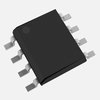Part Details for LTC1329ACS8-50#PBF by Linear Technology
Results Overview of LTC1329ACS8-50#PBF by Linear Technology
- Distributor Offerings: (2 listings)
- Number of FFF Equivalents: (0 replacements)
- CAD Models: (Request Part)
- Number of Functional Equivalents: (0 options)
- Part Data Attributes: (Available)
- Reference Designs: (Not Available)
Tip: Data for a part may vary between manufacturers. You can filter for manufacturers on the top of the page next to the part image and part number.
LTC1329ACS8-50#PBF Information
LTC1329ACS8-50#PBF by Linear Technology is a Digital to Analog Converter.
Digital to Analog Converters are under the broader part category of Converters.
A converter is an electrical circuit that transforms electric energy into a different form that will support a elecrical load needed by a device. Read more about Converters on our Converters part category page.
Price & Stock for LTC1329ACS8-50#PBF
| Part # | Distributor | Description | Stock | Price | Buy | |
|---|---|---|---|---|---|---|
|
DISTI #
2156-LTC1329ACS8-50#PBF-ND
|
DigiKey | IC DAC 8BIT A-OUT 8SO Min Qty: 35 Lead time: 1 Weeks Container: Bulk MARKETPLACE PRODUCT |
100 In Stock |
|
$8.6600 | Buy Now |
|
|
Rochester Electronics | LTC1329 - Micropower 8-Bit Current Output D/A Converter RoHS: Compliant Status: Active Min Qty: 1 | 100 |
|
$6.6900 / $8.3600 | Buy Now |
Part Details for LTC1329ACS8-50#PBF
LTC1329ACS8-50#PBF CAD Models
LTC1329ACS8-50#PBF Part Data Attributes
|
|
LTC1329ACS8-50#PBF
Linear Technology
Buy Now
Datasheet
|
Compare Parts:
LTC1329ACS8-50#PBF
Linear Technology
LTC1329 - Micropower 8-Bit Current Output D/A Converter; Package: SO; Pins: 8; Temperature Range: 0°C to 70°C
|
| Rohs Code | Yes | |
| Part Life Cycle Code | Transferred | |
| Ihs Manufacturer | LINEAR TECHNOLOGY CORP | |
| Part Package Code | SOIC | |
| Package Description | 0.150 INCH, PLASTIC, SO-8 | |
| Pin Count | 8 | |
| Manufacturer Package Code | S8 | |
| Reach Compliance Code | compliant | |
| HTS Code | 8542.39.00.01 | |
| Converter Type | D/A CONVERTER | |
| Input Bit Code | BINARY | |
| Input Format | SERIAL | |
| JESD-30 Code | R-PDSO-G8 | |
| JESD-609 Code | e3 | |
| Length | 4.9 mm | |
| Moisture Sensitivity Level | 1 | |
| Number of Bits | 8 | |
| Number of Functions | 1 | |
| Number of Terminals | 8 | |
| Operating Temperature-Max | 70 °C | |
| Operating Temperature-Min | ||
| Package Body Material | PLASTIC/EPOXY | |
| Package Code | SOP | |
| Package Shape | RECTANGULAR | |
| Package Style | SMALL OUTLINE | |
| Peak Reflow Temperature (Cel) | 260 | |
| Qualification Status | Not Qualified | |
| Seated Height-Max | 1.75 mm | |
| Supply Current-Max | 0.15 mA | |
| Supply Voltage-Nom | 3.3 V | |
| Surface Mount | YES | |
| Temperature Grade | COMMERCIAL | |
| Terminal Finish | Matte Tin (Sn) | |
| Terminal Form | GULL WING | |
| Terminal Pitch | 1.27 mm | |
| Terminal Position | DUAL | |
| Time@Peak Reflow Temperature-Max (s) | 30 | |
| Width | 3.9 mm |
LTC1329ACS8-50#PBF Frequently Asked Questions (FAQ)
-
The recommended PCB layout for the LTC1329ACS8-50#PBF involves keeping the analog and digital grounds separate, using a solid ground plane, and placing the device close to the power supply. Additionally, it's recommended to use a low-ESR capacitor for the output filter and to keep the input and output traces as short as possible.
-
The output filter components for the LTC1329ACS8-50#PBF should be chosen based on the desired output voltage ripple and the load current. A general rule of thumb is to choose a capacitor with a low ESR and a high capacitance value, and a resistor with a low resistance value. The datasheet provides a formula for calculating the recommended output filter component values.
-
The maximum input voltage that the LTC1329ACS8-50#PBF can handle is 15V. Exceeding this voltage may cause damage to the device or affect its performance.
-
The LTC1329ACS8-50#PBF is rated for operation up to 125°C, but its performance may degrade at high temperatures. It's recommended to derate the device's output current and voltage at high temperatures to ensure reliable operation.
-
To troubleshoot issues with the LTC1329ACS8-50#PBF, start by checking the input voltage, output voltage, and output current. Verify that the device is properly connected and that the output filter components are correct. Use an oscilloscope to measure the output voltage ripple and noise. Check the datasheet for troubleshooting guidelines and application notes.
